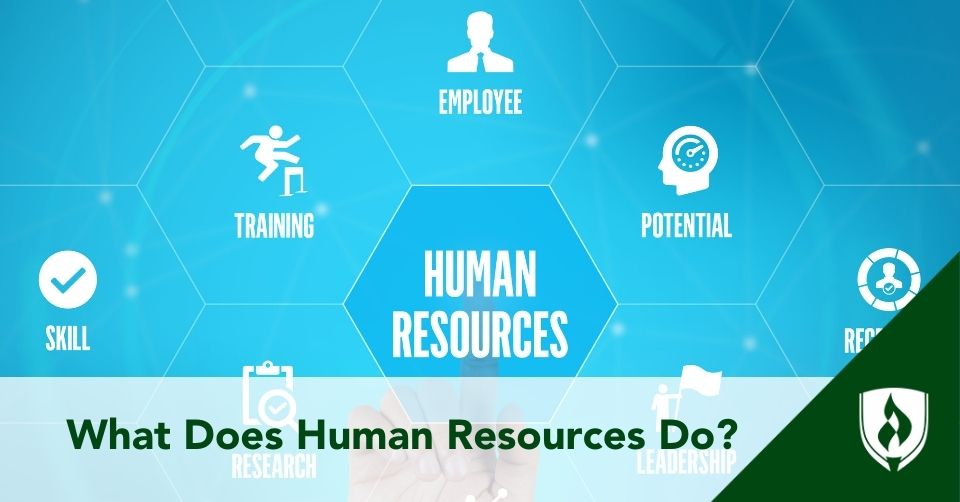What Does Human Resources Do?
04/01/2025

What Is Human Resources (HR)?
Human resources (HR) manages people in working organizations to recruit, find, screen and train job applicants and support employee retention, engagement, and overall productivity.
HR serves as "the link between an organization's management and its employees." HR departments1 find ways to optimize the value of the organization's employees and make sure they're being used effectively.
Key Functions of the HR Department
HR departments encompass1 many functions. From attracting and retaining talent to managing policies, benefits and more, HR plays a key role in an organization's function.
Some main components of the HR department may include:
- Planning and coordinating employee talent
- Planning and overseeing employee benefits
- Coordinate and supervise HR support staff
- Oversee recruitment, interviewing, hiring and training
- Handling and mediating staffing or disputes
- Ensuring compliance with labor laws
- Updating and maintaining company policies
Human Resources Operations
In terms of how human resource departments operates1, HR managers may analyze the job market, consult stakeholders, and manage budgets to ensure the right candidate is attracted and presented during the hiring process.
In terms of other operational duties, HR may responsible for managing taxes, collecting employee work hours, and reimbursing expenses to employees, vendors and contractors. HR may also add raises and bonuses to employee paychecks and ensure compliance with relevant labor laws and regulations.
HR may also investigate employee tardiness or other issues and provide resources to help employees with continuous learning opportunities and professional development.
Human Resources Support for Employees
One of the key functions of the human resources department is to support employees1, although it covers several different areas.
- Recruitment and onboarding: HR manages the entire employee journey, from hiring to onboarding and ongoing support.
- Employee development: HR fosters professional growth by offering training and helping employees set goals and bridge skill gaps.
- Employee engagement and well-being: HR organizes events and provides resources to promote workplace culture and support mental and physical health.
- Benefits and compensation: HR handles pay, insurance, retirement, and other benefits to help employees manage life challenges.
- Performance management: HR conducts performance reviews to align employee goals with company objectives.
- Conflict resolution: HR mediates conflicts and ensures a fair and respectful workplace.
The Role of Human Resources in the Organization
HR may serve as a bridge1 between an organization and its employees to meet both the company's needs as well as the employee's. From aligning with company goals as well as individual employee goals, HR balances both responsibilities from talent management to employee relations, organizational culture and more.
HR works directly with company leadership to align on business strategies. During reorganization or change, HR assists with transitions and supports employees through adjustments.
Best Practices for Human Resources Departments
There are many schools of thought on what the best practices of human resources should be. From the "best fit" approach to the "best practices" approach. "Best fit" typically2 says that HR policies align with a company's strategy whereas "best practice" says that HR methods have a positive impact on an organization's performance and "may lead to high motivation and better employee commitment."
"Best fit advocates the firm's reward system should be aligned to organization strategy; best practice is a group of human resource policies which include a reward system."
One research study3 mentions that some of the best practices "focus on one of five types of HR practice" in leader development, training and knowledge building, employee empowerment, employee recognition and cost management.
According to the Equal Employment Opportunity Commission (EEOC), a task force suggested4 that their best practices for private sector employers included retirement and hiring, promotion and career advancement, terms and conditions, termination and downsizing, alternative dispute resolution, a section for other, and management and commitment and accountability.
As a result, the "best practices" for HR may vary for each organization, depending on its goals, circumstances and what's most important to the company.
Even for the EEOC, the term4 "best practice" is defined for their purposes and context, for example as something that "complies with the law" or "promotes equal employment opportunity and addresses one or more barriers that adversely affect equal employment opportunity."
What Comes Next
Human resources plays a vital role in the success of an organization and its employees.
HR departments typically oversee critical aspects of the employee lifecycle, coordinate employee benefits and ensure compliance with relevant laws and regulations.
HR professionals may play a role in supporting employees' access to professional development resources, continuing education, and training opportunities.
For a deeper understanding of the differences between human capital and human resources, explore our detailed guide on "What Is Human Capital vs. Human Resources".
1Bureau of Labor Statistics, U.S. Department of Labor, Occupational Outlook Handbook, Human Resources Managers. https://www.bls.gov/ooh/management/human-resources-managers.htm#tab-2.
2Kimble, Amy. "Best Fit vs. Best Practice." LinkedIn, https://www.linkedin.com/pulse/best-fit-vs-practice-amy-kimble/.
3Fombrun, Charles J., et al. "Strategic Human Resource Management." Journal of Management, vol. 4, no. 1, 1980, pp. 87–98. https://journals.sagepub.com/doi/10.1177/001088040004100123.
4U.S. Equal Employment Opportunity Commission. "Best Practices for Private Sector Employers." https://www.eeoc.gov/best-practices-private-sector-employers.



